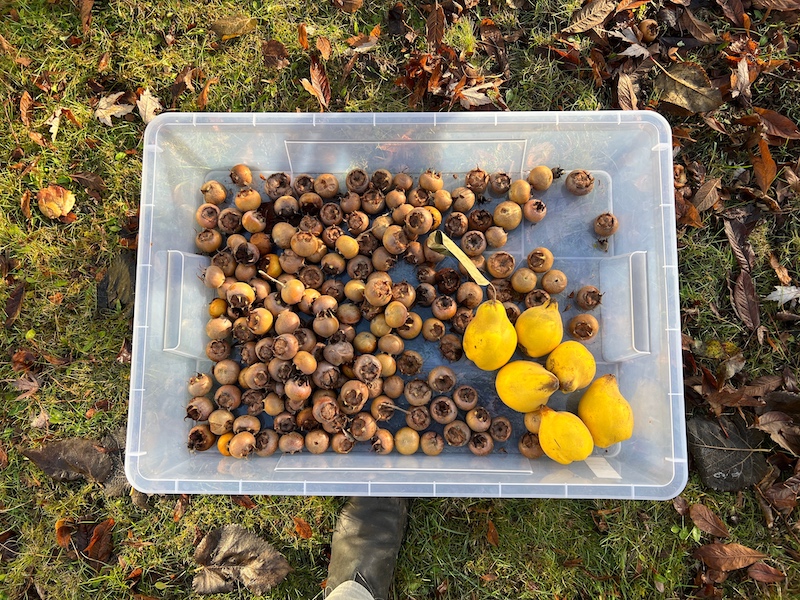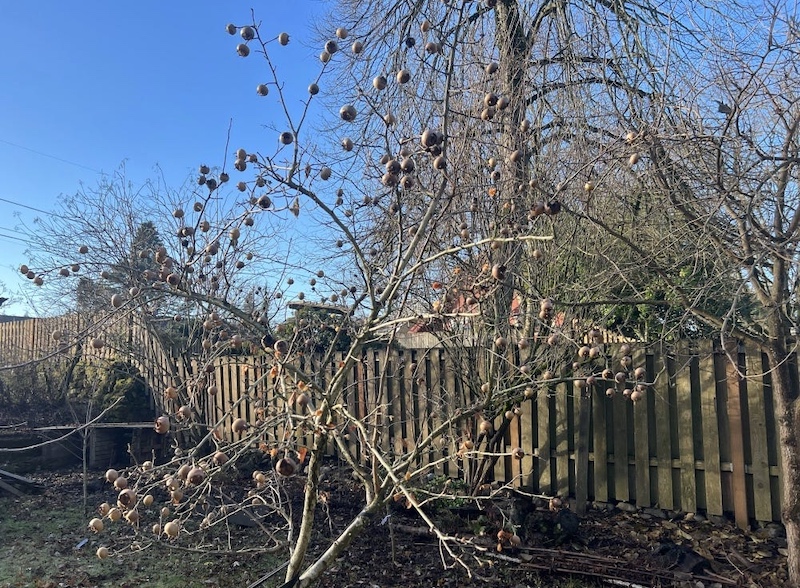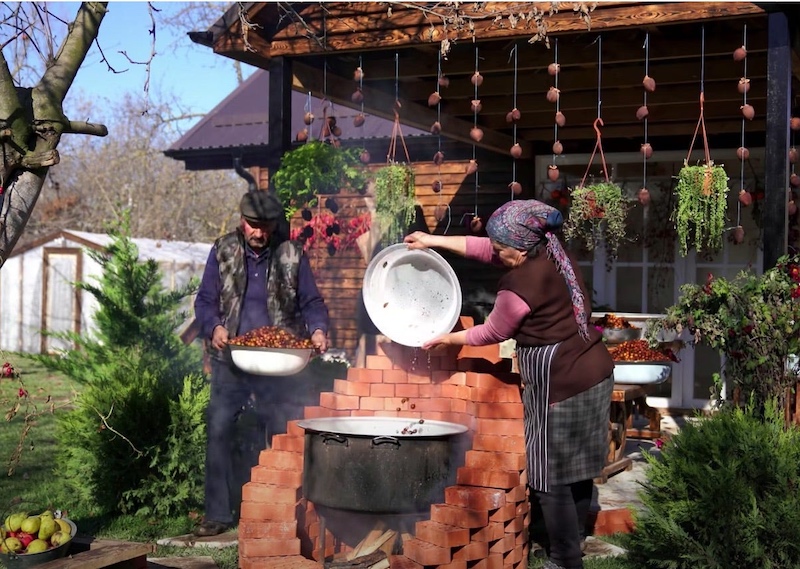
Guest Essay: What Do You Do with a Medlar?
I've been reading—and thoroughly enjoying—local writer and editor Jonathan Kauffman's occasional newsletter, A Place Is a Gift, for awhile now. It's about, as he puts it, "cooking the neighborhood (and giving it away)." But it's also about becoming intimately acquainted with, and becoming a part of, the place you live. As such, it's more than appropriate to share here.
The mystery of an unphotogenic, labor-intensive fruit.
This year, I planned to ignore medlars.
Two summers ago, I was having drinks with friends—one of those pandemic gatherings where everyone sat six feet apart and pretended we weren't freaked out—when Koto mentioned that she had a medlar tree in her backyard orchard.

I had never tasted a medlar before. I had never seen a medlar before. All I knew of medlars was a word in one of the choruses from Amahl and the Night Visitors, the Giancarlo Menotti opera I starred in as a boy soprano: “Olives and quinces, apples and raisins, nutmeg and myrtle, medlars and chestnuts. This is all we shepherds can offer you.”
I begged her to let me try a few fruits when they ripened, and that winter, Koto graciously remembered. She delivered several pounds of hard brown fruit to me with the instruction that I should let them blett, or soften, like persimmons. The ovoid fruits, with their gaping blossom ends, sat in my basement for a month while I looked up things to make with them. No one, it seemed, could share a recipe without describing medlars with a smirk. In Kate Lebo's marvelous lexicon, The Book of Difficult Fruit, for example, she describes a medlar as:
A shriveled, rose-hip-like bulb about the size of a fig, called in Shakespeare's time "open-arse" because its calyx looks (sort of) like the pucker of an anus. ... That medlars are not ripe until they rot—a process called bletting—contributes to their assness, I guess.

After a month with no bletting to speak of, Koto told me that the December frosts had softened the remaining fruit on her medlar tree. This second batch of medlars were so squishy that, when I pressed a finger into them, a brown, grainy muck erupted.
Its sweetness was a subtle as its scent, and the seeds were too big to make the thought of eating a raw medlar appealing. So I followed a well-known food blogger's recipe for medlar jelly, mashing and cooking the fruits until they fell apart, then passing the pulp through a food mill to remove skins and seeds. It became clear why the blogger hadn't documented the process in photos. The assiest of fruit produces a scatological-looking pulp.
After I hung the pulp in a cheesecloth bag overnight, then collected the viscous, honey-like liquid that dripped out, I began to catch hold of the medlar's elusive aroma. The juice smelled as if someone had cooked apples and oats together with fresh sawdust. I wasn't sure I loved it, but I didn't mind it. I added the appropriate amounts of sugar, lemon, and tart green apple and cooked the jelly.
It refused to set.

After two rounds of cooking, I shoved my jars of medlar syrup to the back of the fridge, and figured my curiosity was satisfied. This summer, though, I binge-watched YouTube videos of a cook in rural Azerbaijan [called Country Life Vlog]. Aziza, who layers printed fabrics like a Gen Z influencer, silently cooks massive amounts of food outdoors. (According to an English-language Azeri news site, the filmmaker is her son, a chef in his own right.) In one of the videos, Aziza and her husband build a brick fire pit in order to cook a vat of medlars down into a garlicky sauce, which they serve with beef ribs and hand-made noodles. (The video's long, so start watching at 11:30.)
I wanted to know how that tastes, I thought, then texted the video's URL to Koto. Come December, she texted me back: I don’t have time to process my medlars this year, but they're all bletting on the tree. Take them all.
It was an amazing gift, so of course I took her up on it. The fruit was so soft that if I jiggled a limb, medlars would fall off and hit the ground with a splat. It me took two afternoons to puree the 15 pounds of fruit I gleaned. The yield: two gallons of murky brown sludge.
In the process of cooking all that fruit, breathing in its steam, tasting little spoonfuls, the medlar burrowed into my head. The aroma remained subtle, but it permeated our house for a week, and I could pick it out from all the other smells floating around our house. I began to enjoy it.
It made me think of how my love for people and things—foods, music, cities—is often encased in my intimate knowledge of them. How familiarity is not the same as love, but it traces love's shape.
When people ask me whether I love it here in Portland, I can only say that I love my house, and my friends, and the landscape, and perhaps my neighborhood, which Christian and I have taken hundreds of walks around. In the late-2000s I lived in Seattle for three and a half years, exploring the area as a restaurant critic. By the time I moved away I could get from Federal Way to Kirkland and tell you six great places to eat in White Center. After the same amount of time in Portland—or as we like to say, eight months plus a pandemic—the city still feels like a preliminary sketch. A place that everyone else but me remembers. A community still locked behind its masks.
This winter, however, I'm finally driving around town without turning on Google Maps. Not just to regular destinations like the farmers' market or the barber. When I head out, I know that if I get lost, I can keep driving until something looks familiar—which is more and more of the city. It is a relief. A promise of a deeper kind of love.
As for the medlar purée, some is buried in the freezer, for the day when I feel ambitious enough to make beef ribs with medlar sauce. I attempted the jelly again, combining the strained juice with last year's syrup and a lot more pectin. I ended up with four jars whose contents jiggle when I shake them.
The leftover pulp became medlar cheese. I added heaps of sugar, plus vanilla, allspice, and cloves, then cooked the fruit puree until my spoon could barely move through the mass. According to the online recipes I followed, this was supposed to set up into a shiny, membrillo-like block, but mine didn't do that. So I canned small jars of what I’m calling spiced medlar butter, which I sometimes spread on toast. It is delicious. To be honest, so are most things flavored with sugar, vanilla, allspice, and cloves. Behind their easy charm, though, I can sense medlar's own true flavor. I plan to finish writing this sentence, walk to the refrigerator, and taste it again.
Spoonful by spoonful, I will figure out how to love this fruit.
Subscribe to A Place is a Gift. All photos courtesy Jonathan Kauffman.